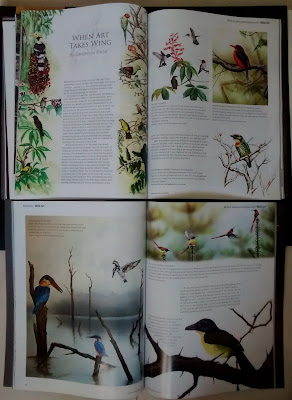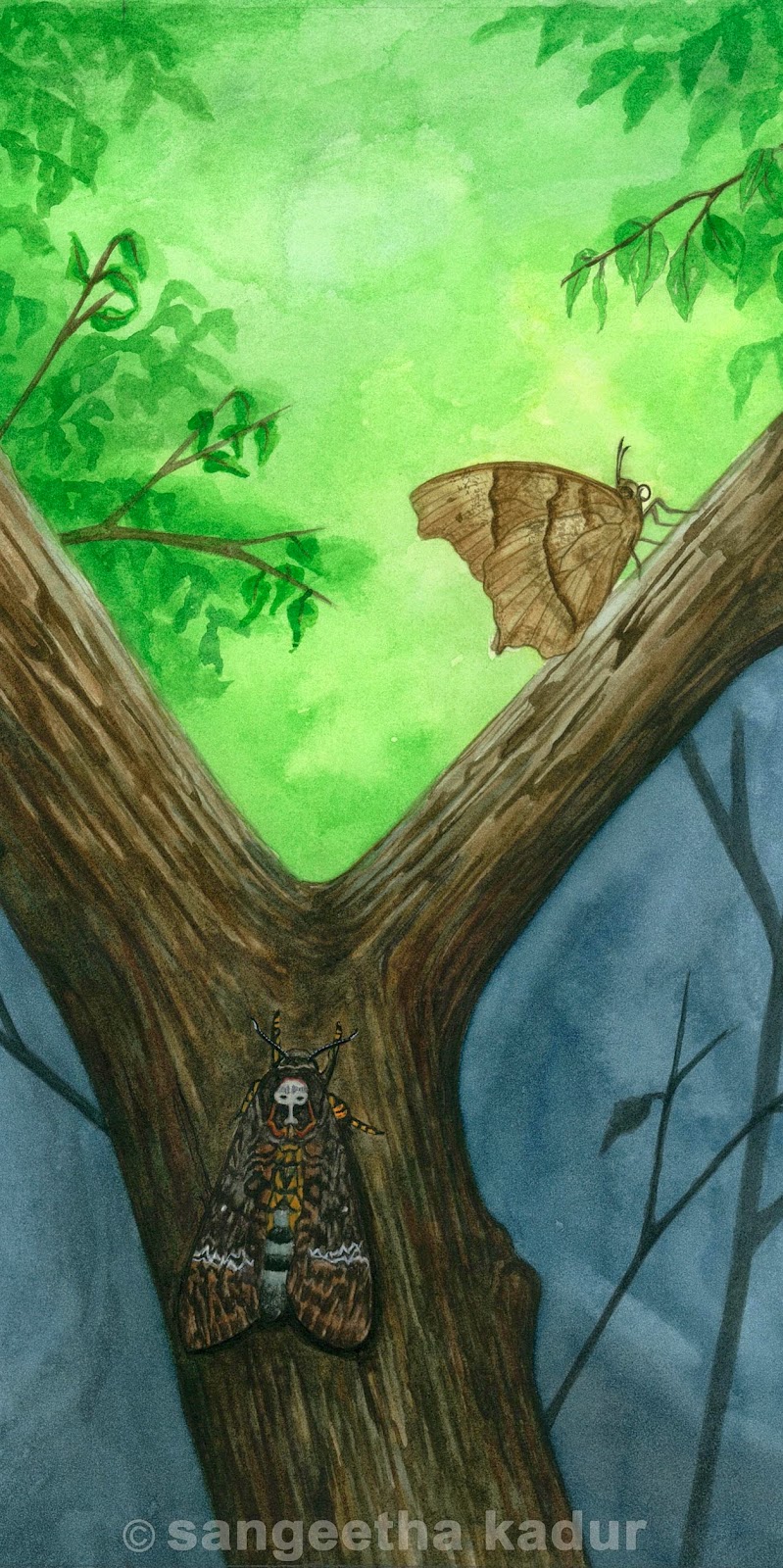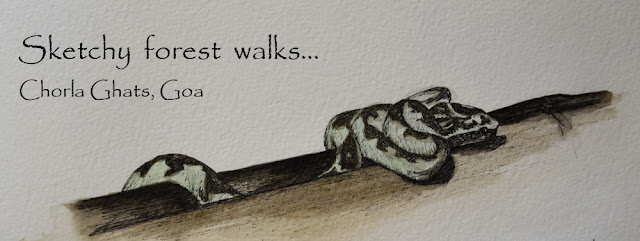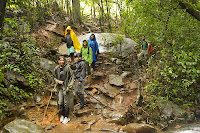As soon as i set foot in the hustle-bustle busy town of Panajim, i was driven off to a forested pocket of the Chorla Ghats, along the the eastern boundary of Goa. Nestled well between the Mhadei Wildlife sanctuary of Goa and the Bhimgad Sanctuary of Karnataka, the mountain range of Chorla Ghats treasures a rich biodiversity of life. I was stationed at Swapnagandha in Wildernest, for a whole week, where i spent my time sketching all that i could, in the winter month of December !
Pasted below are leaves from my journal, frozen in time !


s
The well camouflaged Forest Calotes, Calotes rouxii, in their non-breeding attire are hard to spot when they pose motionless on a tree bark, but every now and then you get a fleeting glimpse when they shoot past your feet, once again, into the dry brown winter woods.
A beautiful green grasshopper attracted to the tube-light at night!
On 2nd December, I accompanied Rahul Khanolkar and a bunch of school children from Belgaum to the plateau, near the Mhadei conservation center. I was amazed by the brown-ness to the whole place. The yellow-ochre-brown glistening with the bright sunlight and swaying in the light breeze weaved the path to the flat plataeu area. With the scattered trees and shrubs interspered within the landscape, it was a sight to behold!

Growing upto a feet long were these beautiful yellow-red inflorescence, standing bright and elegant against the contrasting golden brown plateau. It is locally known as Wakeri, but i am yet to find out the scientific name.
Later, on the night drive, a hollow, lined and plastered with silk on the cut mud wall along the side of the road... a nest of a tarantula !!


A dense forested path leads to a bouldered stream... hop over the boulders and follow the stream up-hill, it opens up to a tall cliff-face, and there, drops down the Valvanti waterfalls. Growing on the damp rocky cliffs, right next to the waterfall are clusters of pink Impatience flowers enjoying the cool showers throughout the day and night.
All day, along the waterfall trek, i had my eyes gleaning through leaf litter, trees, boulders and all the nook and cranny, trying to spot a snake in the wild... dissapointed... i retreated to my room... Well! little did i know, there was one waiting for me right in my balcony!!

A beautiful Malabar Pit viper !!
For 5 days since, it stole all my good mornings and good nights. I paid a number of visits to the balcony, even in the middle of the nights, wondering but happy, and admiring its choice of my balcony! Hovering around this grumpy frown faced visitor at a safe distance, i did manage a few sketches!
On either side of the walking paths, the carpeted web of the funnel web spiders was a very common sight. To ambush their prey they peek out at the entrance; and with the slightest movement or disturbance, they retreat into their woven funnels within an instance.
Known to have a good eye sight, probably they did watch me sketch, i wonder?!
Continuously chirping throughout the day, the Crimson backed sunbirds were busy with their feeding duties and visiting the nest every few minutes.
 Below the dining area of Swapnagandha, attracted to the tube light, were a canvas of moths of myraid shapes, sizes and colours ! Each night there was always something new to look out for.
Below the dining area of Swapnagandha, attracted to the tube light, were a canvas of moths of myraid shapes, sizes and colours ! Each night there was always something new to look out for.

The bright light also drew grasshoppers, beetles and other insects. Along with them a very smart bat ! With the flutter of any moth, the bat would swoop down, over my head and snatch its meal for the night. I sketched and watched and ducked and i lost count of the number of meals it caught and missed!
But two windy nights, with the gusts of wind directly hitting the wall, there was an empty canvas. Sadly, no moths, nor any bat in sight.
Terrible with watercolours and landscapes still. Lots to improve on, but for now, thats the Anjuna dam seen from one side of the dinning area in swapnagandha.
The birdlife promised some excellent sightings of Orange-headed Thrush, Puff-throated Babblers, Red spurfowl, Verditer, Nilgiri and Tickell's flycatcher. The walls were taken over by the most bizarre patterned gecko's by night. Three Vine snakes showed off their presence during my stay.
After 16 years to Goa... What a pleasant comeback its been! A great trip to mark the end to a busy 2012.
An overwhelming gratitude goes to Nirmal Kulkarni, who made this little sketching journey of mine happen! Thank you for your support and the hearty welcome to such a beautiful place restored. I appreciate the work, energy and enthusism put in by the entire Wildernest team, for making it such a haven of a place for nature and life to co-exist.





















































